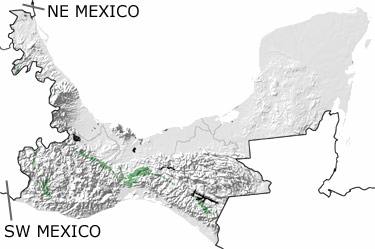Paleontology and geologyDuring the Jurassic, most of the Southeastern Region was above sea level and the land was covered in forests and swamps of cycadophytes, conifers, and ferns. Theropod and sauropod dinosaurs roamed these habitats, as evidenced by footprints preserved in mudstones, sandstones, and shales. In lagoons near the coast, deposits of salt, gypsum, and anhydrite accumulated as sea water evaporated, and in deeper waters, ammonites thrived. In the Middle Jurassic, the Yucatan Peninsula began to split from the ancient southeastern United States as the Gulf of Mexico opened. By the end of the period, the Yucatan had rotated and arrived at its present position, and shallow seas began to flood the region from the east. Throughout the Jurassic, subduction in the west added volcanic islands, slices of oceanic crust, and marine deposits to the southwestern edge of the region. This activity created volcanoes, formed masses of granite below the surface, and folded, faulted, and altered many rocks. |




